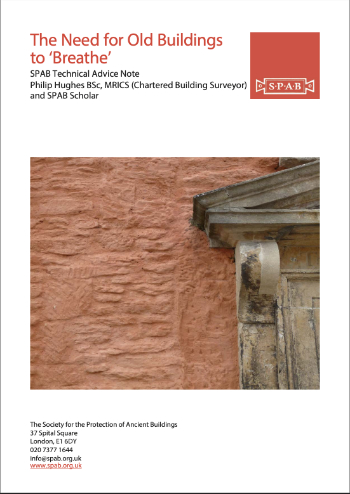SPAB Technical Note. The Need for Old Buildings to 'Breathe'
The Need for Old Buildings to ‘Breathe’ is the title of a Society for the Protection of Ancient Buildings (SPAB) Technical Advice Note and was written by Philip Hughes BSc, MRICS (Chartered Building Surveyor) and SPAB Scholar.
This document gives an excellent explanation of the differences between historical construction methods and materials and modern methods and materials. It describes extremely well the concept of 'breathing' materials, in the context of traditional construction and how their characteristics help prolong the life of historical buildings. It further describes issues relating to the introduction modern or impervious materials in the context of historical buildings and the issues this can cause.
It describes different applications from external render and pointing to internal plaster and paints as well as the nuances and gradations in the breathability of construction materials. It is not only a brief but invaluable resource for homeowners, designers and contractors dealing with historical buildings but also those looking to create modern buildings from natural or breathable materials.
Follow the link for further information about The Society for the Protection of Ancient Buildings (SPAB) and here to download the Technical Advice Note 'The Need for Old Buildings to ‘Breathe’'.
[edit] Related articles on Designing Buildings
- Conservation officer.
- Conservation.
- Defects in stonework.
- Dry hydrate lime mortar.
- Finding stone to conserve historic buildings.
- Hemp lime construction: A guide to building with hemp lime composites.
- High lime low alkali glass.
- Hot-mixed mortars: the new lime revival.
- Hydraulic lime.
- Hydrated lime.
- IHBC articles.
- Lime concrete.
- Lime mortar.
- Lime plaster.
- Lime putty mortar.
- Lime run-off.
- Masonry.
- Mortar.
- Mortar analysis for specifiers.
- Non hydraulic lime.
- Portland cement.
- Putty lime.
- Society for the Protection of Ancient Buildings.
- Soda-lime glass.
- Sourcing stone to repair Exeter Cathedral.
- The Institute of Historic Building Conservation.
- The use of lime mortar in building conservation.
- Types of mortar.
Featured articles and news
Shortlist for the 2025 Roofscape Design Awards
Talent and innovation showcase announcement from the trussed rafter industry.
OpenUSD possibilities: Look before you leap
Being ready for the OpenUSD solutions set to transform architecture and design.
Global Asbestos Awareness Week 2025
Highlighting the continuing threat to trades persons.
Retrofit of Buildings, a CIOB Technical Publication
Now available in Arabic and Chinese aswell as English.
The context, schemes, standards, roles and relevance of the Building Safety Act.
Retrofit 25 – What's Stopping Us?
Exhibition Opens at The Building Centre.
Types of work to existing buildings
A simple circular economy wiki breakdown with further links.
A threat to the creativity that makes London special.
How can digital twins boost profitability within construction?
The smart construction dashboard, as-built data and site changes forming an accurate digital twin.
Unlocking surplus public defence land and more to speed up the delivery of housing.
The Planning and Infrastructure Bill
An outline of the bill with a mix of reactions on potential impacts from IHBC, CIEEM, CIC, ACE and EIC.
Farnborough College Unveils its Half-house for Sustainable Construction Training.
Spring Statement 2025 with reactions from industry
Confirming previously announced funding, and welfare changes amid adjusted growth forecast.
Scottish Government responds to Grenfell report
As fund for unsafe cladding assessments is launched.
CLC and BSR process map for HRB approvals
One of the initial outputs of their weekly BSR meetings.
Building Safety Levy technical consultation response
Details of the planned levy now due in 2026.
Great British Energy install solar on school and NHS sites
200 schools and 200 NHS sites to get solar systems, as first project of the newly formed government initiative.
600 million for 60,000 more skilled construction workers
Announced by Treasury ahead of the Spring Statement.

























